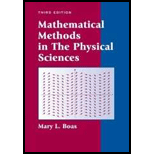
Concept explainers
Find the orthogonal trajectories of each of the following families of curves. In each case, sketch or computer plot several of the given curves and several of their orthogonal trajectories. Be careful to eliminate the constant from
(Assume that
Want to see the full answer?
Check out a sample textbook solution
Chapter 8 Solutions
Mathematical Methods in the Physical Sciences
Additional Math Textbook Solutions
Excursions in Modern Mathematics (9th Edition)
Calculus for Business, Economics, Life Sciences, and Social Sciences (14th Edition)
Introductory Combinatorics
Mathematical Ideas (13th Edition) - Standalone book
Calculus Volume 1
The Heart of Mathematics: An Invitation to Effective Thinking
- Algebra & Trigonometry with Analytic GeometryAlgebraISBN:9781133382119Author:SwokowskiPublisher:Cengage
